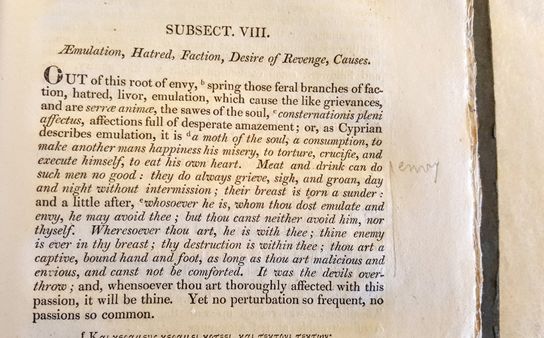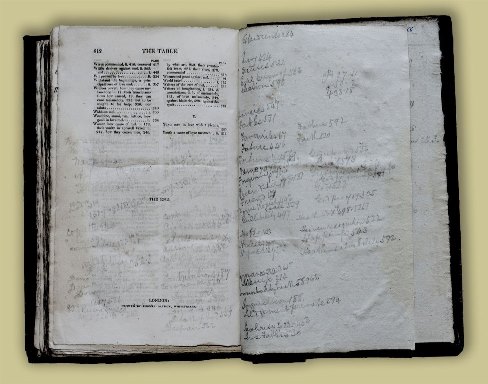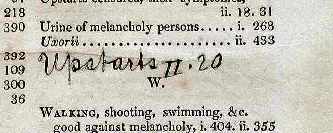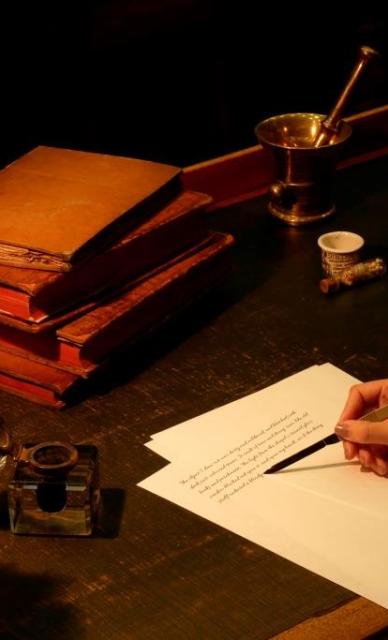Physicians' Gallery Newsletter
Updates on upcoming events, exhibitions and online stories
Empowering medical excellence, shaping healthcare futures.
Having recently spent some weeks investigating the Royal College of Physician’s of Edinburgh’s copies of Robert Burton’s The Anatomy of Melancholy, I was delighted to find some lovely examples of reader interaction within the pages of the 1821 edition. When book historians look for evidence in the history of reading, examples of marginalia are rare but fascinating, revealing much about the inner thoughts of the reader as they encounter the text. The 1821 edition of Burton’s Anatomy is split over two books and has seen heavy usage, with interesting pencil marks scattered throughout both volumes and a fantastic hand-drawn index.
Although readers have been annotating their books for centuries, the term “marginalia” originated with Samuel Taylor Coleridge in the nineteenth century, who used it to describe his handwritten notes around the margins of his books. The term was popularised by Heather Jackson in 2001, and “marginalia” is now used to describe all markings in books, regardless of their location on the page. Books, scrolls and manuscripts have long featured blank spaces of paper around the text, and readers seem unable to resist using these white areas for their own annotations.
This particular copy of The Anatomy of Melancholy is bound very simply in grey paper over lightweight boards, with cloth over the spine. Although the aesthetic of the book is far less decorative than other editions, which are bound in leather, the title, author, volume and publication details on the spine are stamped in gold. Due to a book stamp which features in the first pages of both volumes, we know that this two-volume set was presented to the RCPE Library by “the late Professor G. M. Robertson” in 1932. Professor George Matthew Robertson (1864-1932) was President of the Royal College of Physicians between 1925 and 1927, and donated his personal library to the College on his death. On the front endpaper of the first volume, there is a bookplate attributed to a Samuel Lediard, and another name (which may be R. G. Weldon) is pencilled above. (Unfortunately, there is a notable gap where it looks like Lediard’s bookplate has been forcibly removed from the endpaper of Volume II.) We can infer from this bibliographic information that this book passed through multiple hands before arriving at the RCPE library, and the annotator may therefore have been any one of these people, as there are no signatures claiming ownership of the marginalia.

As Burton’s work is both informative and highly entertaining, readers may have consulted these books for pleasure or for study. However, there are patterns among marginalia, and the examples found within these books imply that the reader was studying the text and deeply engaging with it. Throughout both volumes there are multitudes of pencil lines running vertically down the margin, marking out specific passages of the text as particularly important or relevant to the topic of study. In contrast, readers who consult texts in their leisure time tend to underline favourite sentences and quotations rather than marking out whole passages in this way. Alongside these vertical lines, there is also one example where the annotator has summarised the passage that they have highlighted with one word, “envy”. These types of marginalia spare the student from having to reread the text in full, making the passage physically stick out in the student’s memory for later recall. If a modern reader wished, they could use these physical markers to read only those passages which have been marked by this mysterious writer of the past! Perhaps a future researcher may wish to more deeply investigate which sections this annotator found most interesting.

As stated before, the Anatomy is split into two volumes in this edition, and the printed index appears at the end of Volume II only. Our annotator seems to have found this entirely unacceptable and has actually created their own index at the end of Volume I, in order to better use the first volume as a reference work. There are over 200 indexed terms included in this personal, handmade table, all with various page entries associated with the chosen keyword. This is a wonderful example of a personal index, but it isn’t even the most impressive work of indexing in this set of books!

At the end of Volume II, as mentioned, there is a printed index, spanning both volumes and featuring the locations within the book of key words and ideas. Although this printed index spans nine pages, with multitudes of entries from the very specific, such as “bezoars stone good against melancholy” to the quite general, such as “dancing”, this index was not thorough enough for our annotator. The writer of the marginal annotations throughout the books has added entries to this printed index, too, in order to better use their personal copy of this text. The writer has added categories such as “appearance”, “change”, “deceits”, “fame”, “happiness”, “parentage”, and “upstarts”.

When they ran out of room within the blank spaces of the printed index, they continued onto the final endpapers, covering them in pencil markings with words and references that they might need to locate quickly. The phrase “love” alone has more than 10 page references, and what starts as a neat and tidy index becomes an array of page numbers that curves across the page.

Although there are no clever or amusing doodles or snarky comments within the marginalia of these books, the annotations which appear tell us much about the use of this text. We can tell from just a few pencil lines which passages within the Anatomy were of most use to this student, and which subject areas they found most interesting. This particular copy of one particular book provides ample information about the history of reading, all because of the marginalia.
Author: Isla Macfarlane, Intern, University of Edinburgh, MSc Book History and Material Culture.
References
Beveridge, Allan. "Robertson, George Matthew (1864–1932), psychiatrist." Oxford Dictionary of National Biography. Oxford University Press, 2004. http://www.oxforddnb.com/view/10.1093/ref:odnb/9780198614128.001.0001/odnb-9780198614128-e-35779
Burton, Robert. The Anatomy of Melancholy. London, 1821.
Jackson, Heather. Marginalia: Readers Writing in Books. Yale University Press, 2001.

Updates on upcoming events, exhibitions and online stories